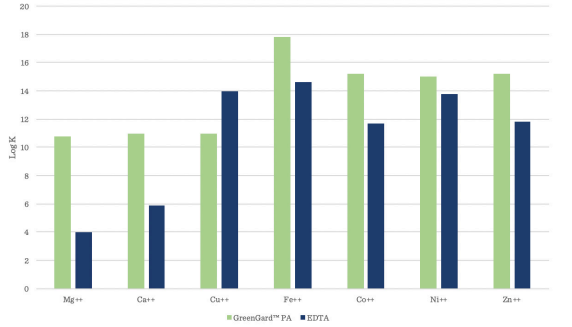Enhanced TDS
Identification & Functionality
- Carrier
- INCI Name
- Manufactured By
- Cosmetic Ingredients Functions
- Technologies
- Product Families
Features & Benefits
- Benefit Claims
- Labeling Claims
- Product Benefits
- 100% Naturally Derived
- High Biodegradability
- Strong chelation at any pH
- Water Soluble
- Efficient & Convenient
- Ideal for All Product Categories
Applications & Uses
- Markets
- Applications
- Personal Hygiene Applications
- Use Level
- 0.05 - 0.2%
- Formulation Guidelines
- Add to water phase at any time
- Avoid use in W/O emulsions using mineral salts (i.e. magnesium stearate)
- Pink discoloration may result when used in combination with avobenzone
- Procedure
Add easily to water phase and incorporate by mixing. If working with acid- sensitive materials, combineGreenGard™ PA in water before adding.
Properties
- Physical Form
- Appearance
- Pale yellow dark brown viscous liquid
- SDS Physical and Chemical Properties
Value Units Test Method / Conditions Physical State Liquid - - Odor Characteristic - - pH max. 1 - - Density 1.45 g/cm³ - Miscible in Water - - Viscosity 12 mPa.s - - Specifications
Value Units Test Method / Conditions Inorganic Phosphorus Content 0.00 - 1.00 % - Phytic Acid Content 48 - 52 % - Heavy Metals Content (as Pb) max. 1 mg/kg - Arsenic Content max. 2 ppm - Sulfate Content max. 0.072 % - Chloride Content max. 0.04 % - - Note
This product contains natural ingredients and there may be color & odor variations from lot to lot due to crop fluctuations from harvest to harvest.
Regulatory & Compliance
- Chemical Inventories
Technical Details & Test Data
- Chelating Comparison of Edta and Phytic Acid
EDTA (ethylenediamine tetraacetic acid) is a common chelating agent that can be found in many beauty products. This ingredient prevents other ingredients from binding with trace elements (such as minerals) that can be present in water. It is used to help prevent deterioration, increase effectiveness and improve the stability of a product. However, EDTA is not readily biodegradable and can act as an environmental pollutant, mobilizing toxic heavy metals from sediments found in our waterways.
GreenGard PA and EDTA chelating capacity for different heavy metal ions at pH=6

The chart to the left compares the ability of GreenGard™ PA and EDTA to form complexes with different ions. Phytic acid and its sodium salts are comparable to EDTA and are ideal replacements.
Packaging & Availability
Storage & Handling
- Shelf Life
- 36 months
